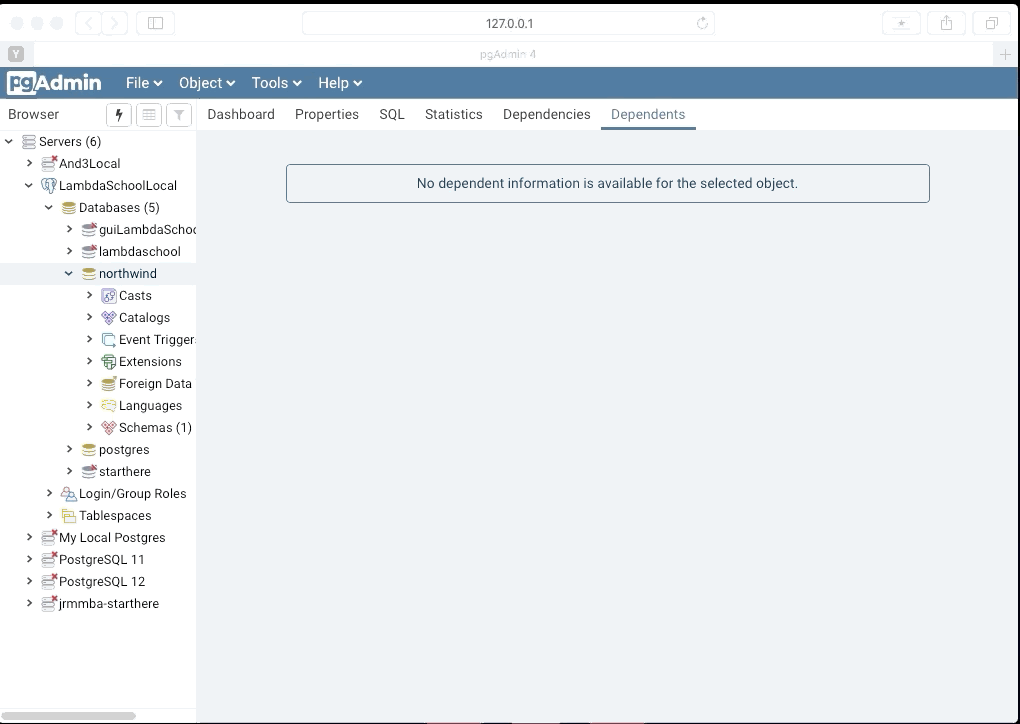A student that completes this project shows that they can:
- Query data from a single table
- Query data from multiple tables
- Create a new database using PostgreSQL
Working with SQL
Reimport the Northwind database into PostgreSQL using pgAdmin. This is the same data we used during the guided project.
-
pgAdmin data refresh
-
Select the northwind database created during the guided project.
-
Tools -> Query Tool
- Open file northwind.sql (you used this script during the guided project)
- Execute
-
Look under
- northwind -> Schemas -> public -> tables
-
Clear query windows
Answer the following data queries. Keep track of the SQL you write by pasting it into this document under its appropriate header below in the provided SQL code block. You will be submitting that through the regular fork, change, pull process
-
find all customers that live in London. Returns 6 records
hint
- This can be done with SELECT and WHERE clauses
-
find all customers with postal code 1010. Returns 3 customers
hint
- This can be done with SELECT and WHERE clauses
-
find the phone number for the supplier with the id 11. Should be (010) 9984510
hint
- This can be done with SELECT and WHERE clauses
-
list orders descending by the order date. The order with date 1998-05-06 should be at the top
hint
- This can be done with SELECT, WHERE, and ORDER BY clauses
-
find all suppliers who have names longer than 20 characters. Returns 11 records
hint
- This can be done with SELECT and WHERE clauses
- You can use
length(company_name)to get the length of the name
-
find all customers that include the word 'MARKET' in the contact title. Should return 19 records
hint
- This can be done with SELECT and a WHERE clause using the LIKE keyword
- Don't forget the wildcard '%' symbols at the beginning and end of your substring to denote it can appear anywhere in the string in question
- Remember to convert your contact title to all upper case for case insensitive comparing so upper(contact_title)
-
add a customer record for
-
customer id is 'SHIRE'
-
company name is 'The Shire'
-
contact name is 'Bilbo Baggins'
-
the address is '1 Hobbit-Hole'
-
the city is 'Bag End'
-
the postal code is '111'
-
the country is 'Middle Earth'
hint
- This can be done with the INSERT INTO clause
-
update Bilbo Baggins record so that the postal code changes to "11122"
hint
- This can be done with UPDATE and WHERE clauses
-
list orders grouped and ordered by customer company name showing the number of orders per customer company name. Rattlesnake Canyon Grocery should have 18 orders
hint
- This can be done with SELECT, COUNT, JOIN and GROUP BY clauses. Your count should focus on a field in the Orders table, not the Customer table
- There is more information about the COUNT clause on W3 Schools
-
list customers by contact name and the number of orders per contact name. Sort the list by the number of orders in descending order. Jose Pavarotti should be at the top with 31 orders followed by Roland Mendal with 30 orders. Last should be Francisco Chang with 1 order
hint
- This can be done by adding an ORDER BY clause to the previous answer and changing the group by field
-
list orders grouped by customer's city showing the number of orders per city. Returns 69 Records with Aachen showing 6 orders and Albuquerque showing 18 orders
hint
- This is very similar to the previous two queries, however, it focuses on the City rather than the Customer Names
Note: This step does not use PostgreSQL!
- Take the following data and normalize it into a 3NF database
| Person Name | Pet Name | Pet Type | Pet Name 2 | Pet Type 2 | Pet Name 3 | Pet Type 3 | Fenced Yard | City Dweller |
|---|---|---|---|---|---|---|---|---|
| Jane | Ellie | Dog | Tiger | Cat | Toby | Turtle | No | Yes |
| Bob | Joe | Horse | No | No | ||||
| Sam | Ginger | Dog | Miss Kitty | Cat | Bubble | Fish | Yes | No |
Below are some empty tables to be used to normalize the database
- Not all of the cells will contain data in the final solution
- Feel free to edit these tables as necessary
Table Name:
Table Name:
Table Name:
Table Name:
- delete all customers that have no orders. Should delete 2 (or 3 if you haven't deleted the record added) records
-
Create Database and Table: After creating the database, tables, columns, and constraint, generate the script necessary to recreate the database. This script is what you will submit for review
-
use pgAdmin to create a database, naming it
budget. -
add an
accountstable with the following schema:id, numeric value with no decimal places that should autoincrement.name, string, add whatever is necessary to make searching by name faster.budgetnumeric value.
-
constraints
- the
idshould be the primary key for the table. - account
nameshould be unique. - account
budgetis required.
- the
To see the script
- Right Click on the database name
- Select Backup...
- Set a filename
- To put the file backup.sql in your home directory, you could use
backup.sql
- To put the file backup.sql in your home directory, you could use
- Set format to
Plain
- Set a filename
- Select Backup...
- The script you want is now in the text file named above.
- Copy the script from the text file into the SQL code block above!
